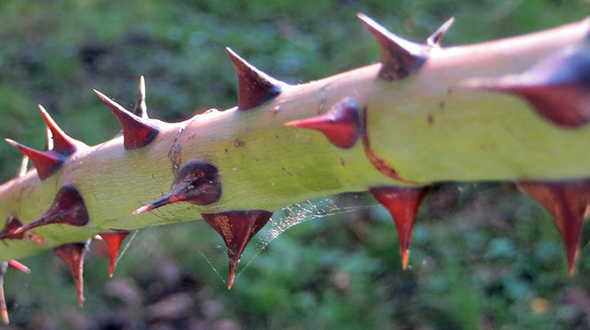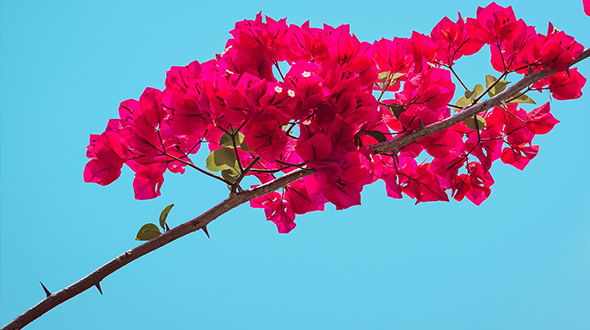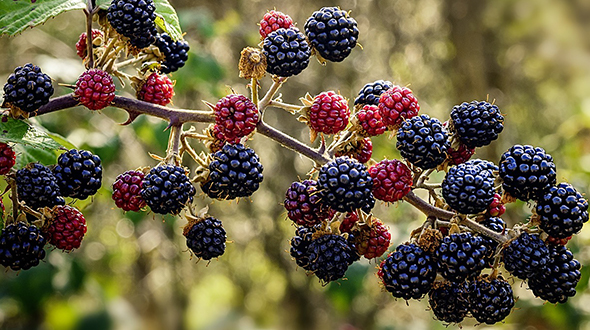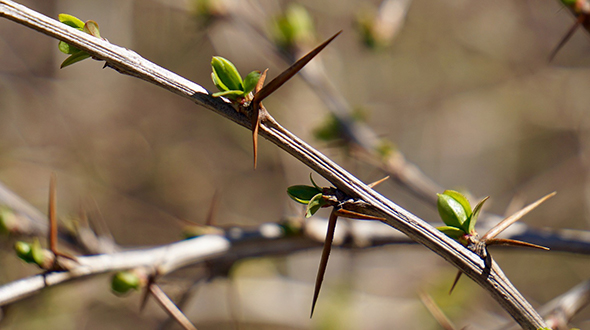
Prevent thieves from gaining easy access to your home’s windows using certain shrubs and an intentional landscape design. Knowing which bushes with thorns to plant in your yard will help take your home’s defense to another level.
toddsmariettatreeservices.com gathered the following species, growing, and care information about thorny bushes that can enhance your property’s security system.
1. Rose (Rosa)

A rose bush is a woody perennial flowering plant named for the flower it bears. There are more than three hundred species and thousands of cultivars. They form a group of plants that can be full-bodied shrubs, climbing, or trailing, with stems often armed with sharp thorns.
Sun – Roses bushes thrive on direct sunlight and will perform their best when planted in locations that provide a minimum of four hours of direct sunlight.
Soil – This species requires good drainage and rich, moisture-retentive soil, preferably with a 6.5 to 7 pH.
Water – In temperate climates, two inches of weekly watering is often all that is needed.
Thorns – You may be interested to know that roses do not have thorns. They do have prickles. Thorns are defined as modified leaf stems or parts of leaves, while prickles grow from the stem’s epidermis. Rose prickles grow to keep away predators.
2. Bougainvillea (Bougainvillea)

Bougainvillea is a vigorous and chaotic plant producing long, trailing stems covered in sharp spines. This species can be grown as a climber or pruned into a free-standing shrub reaching up to 10 feet in height.
Sun – This species needs a minimum of six hours of daily sun.
Soil – This flowering, thorny bush grows thin roots, making a well-drained soil essential to its survival.
Water – You can help this species avoid fungal diseases and root rot by providing deep waterings every three to four weeks.
Thorns – This plant’s thorns are sharper than rose thorns and will easily scratch or prick. Unlike roses and other thorny plants, bougainvillea thorns have a coating at the tip designed to cause irritation.
3. Pyracantha (Pyracantha)

Appearances can differ depending on the species, but the shrub typically has brilliant evergreen foliage, white flowers that produce clusters of orange-red berries, and needle-like protective thorns. The bush’s size can range from 5 to 12 feet high and 6 to 8 feet wide.
Sun – This species prefers six to eight hours of daily sun.
Soil – Planting this bush in highly fertile, well-drained soil will produce rampant growth.
Water – One inch of water per week or more during hot and arid periods provides enough moisture for the bush.
Thorns – Also referred to as firethorn (due to its flame-colored berries and prickly stems), this is a beautiful, easy-going, wildlife-friendly thorny shrub suitable for most gardens.
4. Blackberry (Rubus)

Blackberry is most typically a shrub-like wildflower, measuring 5 to 7 feet tall. The species can be identified by its juicy, black, clustered berries and compound leaves. The radially symmetrical, white flowers bloom atop the bush’s terminal shoots of very thorny, robust stems.
Sun – This species prefers eight hours of daily sun.
Soil – Blackberries perform best in well-drained sandy or loamy soil types with a 5.5 to 6.5 pH.
Water – Blackberries require 1 to 2-inches of water per week in the growing season and 4-inches per week during harvest.
Thorns – Thorns are woody and relatively stronger and tougher than those of other species. Also, this bush’s thorns are difficult to break.
5. Holly (Ilex)

Holly can be grown as large shrubs or trees, many of which have thick, spiky leaves, small white flowers, and yellow, orange, black, or red berries.
Sun – Holly trees thrive in full sunlight. However, they can easily tolerate partial shade.
Soil – Holly species thrive in loamy, well-drained soil kept evenly moist, with an acidic 5.0 to 6.0 pH.
Water – Established bushes should receive at least 2-inches of water per week.
Thorns – The edge of the leaves on this popular bush is wavy with spiny teeth.
6. Barberry (Berberis)

This shrub species has leathery leaves that turn red or orange in the fall and tiny yellow springtime flowers. The species doesn’t produce fruit and has sharp thorns that can help keep deer and people away.
Sun – This species prefers four to six hours of daily sun.
Soil – These robust bushes can tolerate various soil types but will thrive in loamy, well-drained soil with a 6.0 to 7.5 pH.
Water – Once established, this species is extremely drought tolerant and low maintenance, requiring only occasional watering.
Thorns – This evergreen bush has extremely sharp, thorny branches.
Thorny Bushes
In this article, you discovered multiple bush species that grow with thorns and can provide a very effective security barrier around your home’s perimeter.
Planting thorny bushes in your landscape can add definition and style to it while providing an additional layer of security against unwanted stalkers and intruders.
Not planting deterrent bushes around your property can leave you vulnerable to crooks and thieves trying to gain from your lack of security.
Sources:
gardeningsolutions.ifas.ufl.edu/plants/trees-and-shrubs/shrubs/holly.html
hgic.clemson.edu/factsheet/growing-roses/
plants.ces.ncsu.edu/plants/bougainvillea/
landscapeplants.oregonstate.edu/plants/pyracantha
heritagegarden.uic.edu/blackberry
extension.umd.edu/resource/japanese-barberry
(678) 505-0266
Originally published on: http://www.toddsmariettatreeservices.com/bushes-with-thorns-for-increased-home-security/

No comments:
Post a Comment